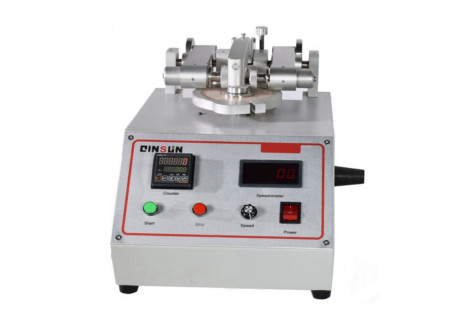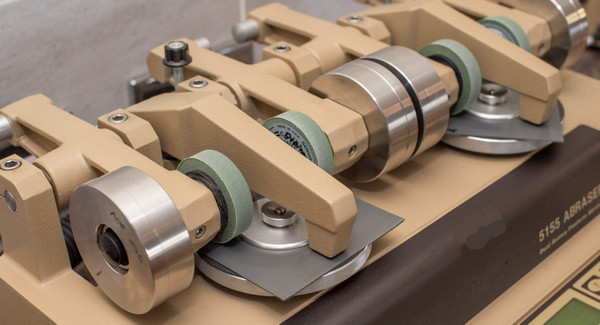- Qinsun Instruments Co., Ltd.
- Tell:+86-21-6780 0179
- Phone:+86-17740808215
- Address:No. 2578 Minhang District Gu Dai Road, Shanghai
- Contact:Mr. Li
- QQ:846490659
What is the taber abrasion test method?

The Taber Abrasion Test is a widely used method for assessing the abrasion resistance of various materials, including plastics, coatings, textiles, and ceramics. It was developed by the Taber Industries company in the 1930s and has since become a standard test in many industries.
The purpose of the Taber Abrasion Test is to simulate and quantify the wear and tear that materials may experience during their service life. By subjecting a material to controlled abrasive conditions, it is possible to measure its resistance to abrasion and compare it with other materials or industry standards.
The test involves placing a flat specimen on a rotating turntable, which is covered with a specified abrasive material, such as sandpaper. The specimen is then subjected to a specific load while the turntable rotates. As the specimen rotates against the abrasive surface, the resulting friction causes abrasion, leading to the formation of wear tracks on the material's surface.

There are two main types of Taber Abrasion Test methods: the dry method and the wet method. In the dry method, no additional media, such as water or lubricants, are added during the test. This method is commonly used to evaluate the abrasion resistance of solid materials like plastics and metals.
On the other hand, the wet method involves introducing a fluid or slurry onto the specimen's surface during the test. This method is often used to assess the abrasion resistance of materials that encounter liquid environments, such as coatings and textiles. The addition of the fluid aims to replicate real-world conditions more accurately.
To ensure repeatability and accuracy, certain parameters are carefully controlled during the Taber Abrasion Test. These parameters include the test load, the rotational speed of the turntable, the test duration, and the type and grit size of the abrasive material. Standardized testing procedures provided by organizations like ASTM International provide detailed instructions on how to perform the test correctly.
The test load represents the applied force exerted on the specimen during the test. The weight or load is typically specified in grams or pounds and can range from a few hundred grams to several kilograms, depending on the material being tested. Higher test loads often result in more significant abrasion damage.
The rotational speed of the turntable determines how quickly the specimen rotates against the abrasive surface. This parameter is usually set at a constant speed, typically measured in revolutions per minute (RPM). Common rotational speeds range from 60 to 100 RPM, but they can vary depending on the material being tested and industry-specific requirements.
The test duration defines the length of time the specimen is subjected to abrasion. The duration can vary based on the material's expected service life or industry standards. Typical test durations range from a few hundred to thousands of cycles, with one cycle representing a single rotation of the specimen against the abrasive surface.
The choice of the abrasive material is crucial as it determines the severity and type of wear experienced by the specimen. Different types of abrasive materials are available, such as sandpaper discs with varying grit sizes, diamond pads, or emery cloth. The selection depends on factors like the material being tested, the intended application, and industry standards.

After the test is completed, the wear resistance of the material is evaluated by measuring the amount of material loss or the change in surface roughness. Various measurement techniques can be employed, such as weight loss analysis, profilometry, or visual inspection using magnification devices. These measurements help quantify the material's resistance to abrasion and provide valuable information for quality control, product development, and material selection purposes.
The Taber Abrasion Test method has found applications across various industries. It is commonly used in automotive manufacturing to evaluate the durability of interior components and coatings, such as dashboard trims and seat fabrics. In the textile industry, the test is used to assess the abrasion resistance of fabrics, including upholstery, carpets, and apparel materials.
Coating manufacturers rely on the Taber Abrasion Test to evaluate the performance of protective coatings on surfaces exposed to wear, such as floors, walls, and architectural finishes. The test is also utilized in the plastics industry to assess the abrasion resistance of molded plastic components, such as buttons, knobs, and housings.
By subjecting materials to controlled abrasion conditions, the Taber Abrasion Test allows for accurate and repeatable measurement of their durability and abrasion resistance. The data obtained from this test method helps engineers, designers, and manufacturers make informed decisions regarding material selection, product development, and quality control, ensuring that the final products meet or exceed customer expectations.





